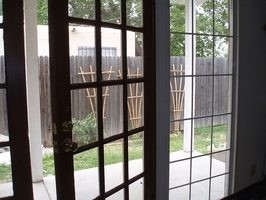Safety Rules For Safety Glass In Doors

Safety glass is designed to minimize cuts and injuries in the event that the glass is broken. Rather than breaking into dangerous shards, safety glass crumbles into tiny pieces that pose minimal threat to those nearby. Safety glass may include laminated, tempered or wired glass units. Laminated glass is used in car windows, and contains a layer of film that holds the glass together when broken. Tempered glass is engineered to shatter into small pieces, and is the most common glass found in doors. Wired glass has virtually been phased out of most U.S. building codes, though it is still used in some jurisdictions.
Regulating Bodies
Safety glass guidelines are set by the Consumer Products Safety Commission (CPSC). CPSC Standard 16 CFR Part 1201 addresses architectural glazing safety in residential and commercial structures. This standard was adopted into the International Building Code (IBC) in 1977, and has since been added to most local and regional building codes. CPSC 1201 allows laminate or tempered glass to be used to meet safety glass requirements as long as the material meets the manufacturing and testing standards under ANSI Z97.1.
Swinging Doors
Safety glazing must be provided in all unframed swinging doors no matter how large the area of the glass. It is also required on framed doors with individual glass panes larger than 9 square feet, or doors with glass located less than 18 inches above the floor.
Sliding Doors
All sliding glass doors and patios assemblies must be constructed with safety glass. Any inoperable or fixed panels included in these assemblies also fall under this requirement. Interior sliding glass doors or closets and wardrobes also require the use of safety glass.
Storm Doors
Exterior storm and screen doors designed to provide protection from wind and storms must be equipped with safety glass. This standard applies regardless of the size of the glass panel in these doors.
Sidelites
A sidelite is an inoperable glass panel that is traditionally located next to a door. Under CSPC 1201, sidelites must be equipped with safety glass if they are within 24 inches of the closed door. Safety glass should also be provided if the bottom edge of the glass is less than 60 inches above the floor.
Shower and Bath Doors
Glass shower doors and tub enclosures should always be built using safety glass. This requirement also applies to enclosures for hot tubs, sauna, steam rooms and whirlpools. Any additional glazing within these structures should contain safety glass if the bottom edge of the glass is less than 60 inches above the floor.
Exceptions
Some exceptions to these requirements are listed in the Standard. Safety glass need not be provided in any door panel that a 3-inch sphere-shaped object could not pass through. It is also not required if leaded or decorative glass. When safety glazing is required because the glass is located near ground level, a protective metal bar can be installed in place of safety glass.
Regulating Bodies
Safety glass guidelines are set by the Consumer Products Safety Commission (CPSC). CPSC Standard 16 CFR Part 1201 addresses architectural glazing safety in residential and commercial structures. This standard was adopted into the International Building Code (IBC) in 1977, and has since been added to most local and regional building codes. CPSC 1201 allows laminate or tempered glass to be used to meet safety glass requirements as long as the material meets the manufacturing and testing standards under ANSI Z97.1.
Swinging Doors
Safety glazing must be provided in all unframed swinging doors no matter how large the area of the glass. It is also required on framed doors with individual glass panes larger than 9 square feet, or doors with glass located less than 18 inches above the floor.
Sliding Doors
All sliding glass doors and patios assemblies must be constructed with safety glass. Any inoperable or fixed panels included in these assemblies also fall under this requirement. Interior sliding glass doors or closets and wardrobes also require the use of safety glass.
Storm Doors
Exterior storm and screen doors designed to provide protection from wind and storms must be equipped with safety glass. This standard applies regardless of the size of the glass panel in these doors.
Sidelites
A sidelite is an inoperable glass panel that is traditionally located next to a door. Under CSPC 1201, sidelites must be equipped with safety glass if they are within 24 inches of the closed door. Safety glass should also be provided if the bottom edge of the glass is less than 60 inches above the floor.
Shower and Bath Doors
Glass shower doors and tub enclosures should always be built using safety glass. This requirement also applies to enclosures for hot tubs, sauna, steam rooms and whirlpools. Any additional glazing within these structures should contain safety glass if the bottom edge of the glass is less than 60 inches above the floor.
Exceptions
Some exceptions to these requirements are listed in the Standard. Safety glass need not be provided in any door panel that a 3-inch sphere-shaped object could not pass through. It is also not required if leaded or decorative glass. When safety glazing is required because the glass is located near ground level, a protective metal bar can be installed in place of safety glass.
- 30fbb57a38130ec81f994b9aee60f8821a.jpg